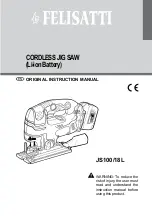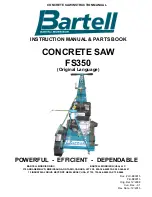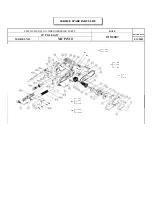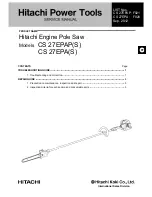
3
GENERAL SAFETY RULES
WARNING:
Read and understand all instructions.
Failure to follow
all instructions listed below, may result in electric shock,
fire and/or serious personal injury.
READ ALL INSTRUCTIONS
KNOW YOUR POWER TOOL.
Read the operator’s manual
carefully. Learn the applications and limitations as well
as the specific potential hazards related to this tool.
GUARD AGAINST ELECTRICAL SHOCK BY PREVENT-
ING BODY CONTACT WITH GROUNDED SURFACES.
For example: pipes, radiators, ranges, refrigerator enclo-
sures.
KEEP GUARDS IN PLACE
and in good working order.
REMOVE ADJUSTING KEYS AND WRENCHES.
Form
habit of checking to see that keys and adjusting wrenches
are removed from tool before turning it on.
KEEP WORK AREA CLEAN.
Cluttered areas and benches
invite accidents.
DO NOT
leave tools or pieces of wood
on the tool while it is in operation.
DO NOT USE IN DANGEROUS ENVIRONMENTS.
Do
not use power tools in damp or wet locations or expose
to rain. Keep the work area well lit.
KEEP CHILDREN AND VISITORS AWAY.
All
visitors should wear safety glasses and be kept a safe
distance from work area. Do not let visitors contact
tool or extension cord while operating.
MAKE WORKSHOP CHILDPROOF
with padlocks,
master switches, or by removing starter keys.
DON’T FORCE THE TOOL.
It will do the job better and
safer at the feed rate for which it was designed.
USE THE RIGHT TOOL.
Do not force the tool or attach-
ment to do a job for which it was not designed.
USE THE PROPER EXTENSION CORD.
Make sure your
extension cord is in good condition. Use only a cord heavy
enough to carry the current your product will draw. An
undersized cord will cause a drop in line voltage result-
ing in loss of power and overheating. A wire gauge size
(A.W.G.) of at least
14
is recommended for an extension
cord 25 feet or less in length. If in doubt, use the next
heavier gauge. The smaller the gauge number, the heavier
the cord.
DRESS PROPERLY.
Do not wear loose clothing,
neckties, or jewelry that can get caught and draw you into
moving parts. Rubber gloves and nonskid footwear are
recommended when working outdoors. Also wear
protective hair covering to contain long hair.
ALWAYS WEAR SAFETY GLASSES WITH SIDE
SHIELDS.
Everyday eyeglasses have only impact-
resistant lenses, they are
NOT
safety glasses.
SECURE WORK.
Use clamps or a vise to hold work
when practical, it is safer than using your hand and frees
both hands to operate the tool.
DO NOT OVERREACH.
Keep proper footing and
balance at all times.
MAINTAIN TOOLS WITH CARE.
Keep tools sharp
and clean for better and safer performance. Follow
instructions for lubricating and changing accessories.
DISCONNECT TOOLS.
When not in use, before
servicing, or when changing attachments, blades, bits,
cutters, etc., all tools should be disconnected from power
source.
AVOID ACCIDENTAL STARTING.
Be sure switch is off
when plugging in any tool.
USE RECOMMENDED ACCESSORIES.
Consult the
operator’s manual for recommended accessories. The
use of improper accessories may result in injury.
NEVER STAND ON TOOL.
Serious injury could occur if
the tool is tipped.
CHECK DAMAGED PARTS.
Before further use of the
tool, a guard or other part that is damaged should be
carefully checked to determine that it will operate properly
and perform its intended function. Check for alignment
of moving parts, binding of moving parts, breakage of
parts, mounting and any other conditions that may affect
its operation. A guard or other part that is damaged must
be properly repaired or replaced by an authorized service
center to avoid risk of personal injury.
USE THE RIGHT DIRECTION OF FEED.
Feed work into
a blade, cutter, or sanding spindle against the direction
or rotation of the blade, cutter, or sanding spindle only.
NEVER LEAVE TOOL RUNNING UNATTENDED. TURN
THE POWER OFF.
Don't leave tool until it comes to a
complete stop.
PROTECT YOUR LUNGS.
Wear a face or dust mask if
the cutting operation is dusty.
PROTECT YOUR HEARING.
Wear hearing protection
during extended periods of operation.
DO NOT ABUSE CORD.
Never carry tool by the cord or
yank it to disconnect from receptacle. Keep cord from
heat, oil, and sharp edges.
USE OUTDOOR EXTENSION CORDS.
When tool
is used outdoors, use only extension cords with
approved ground connection that are intended for use
outdoors and so marked.
KEEP BLADES CLEAN, SHARP, AND WITH
SUFFICIENT SET.
Sharp blades minimize stalling
and kickback.
BLADE COASTS AFTER BEING TURNED OFF.
NEVER USE IN AN EXPLOSIVE ATMOSPHERE.
Normal sparking of the motor could ignite fumes.
Summary of Contents for TS1342
Page 29: ...29 NOTES...




































